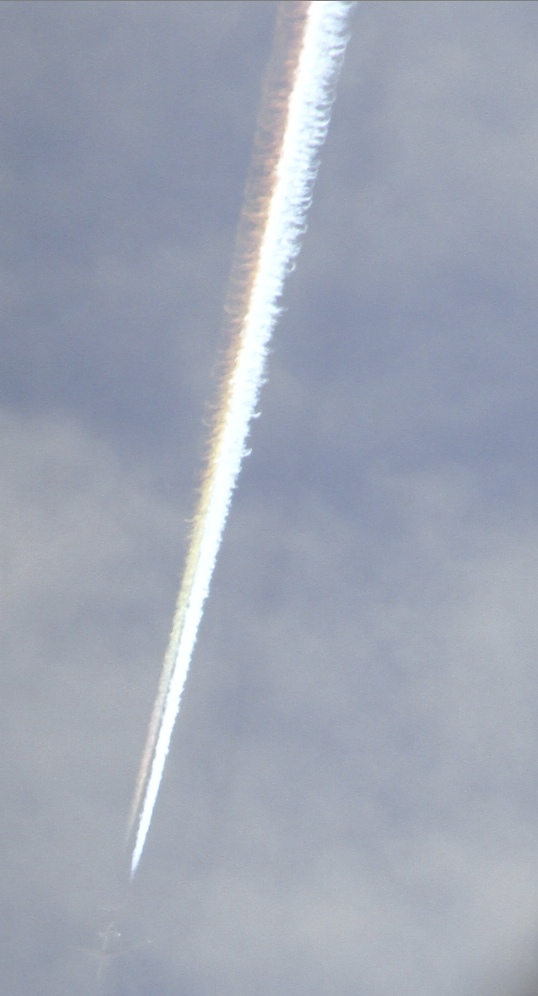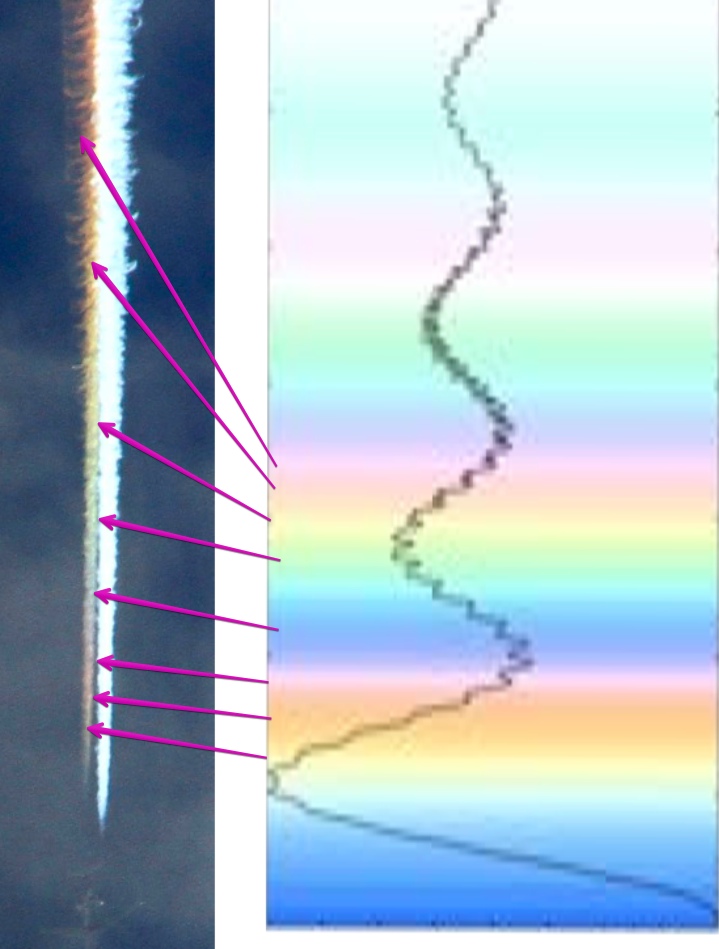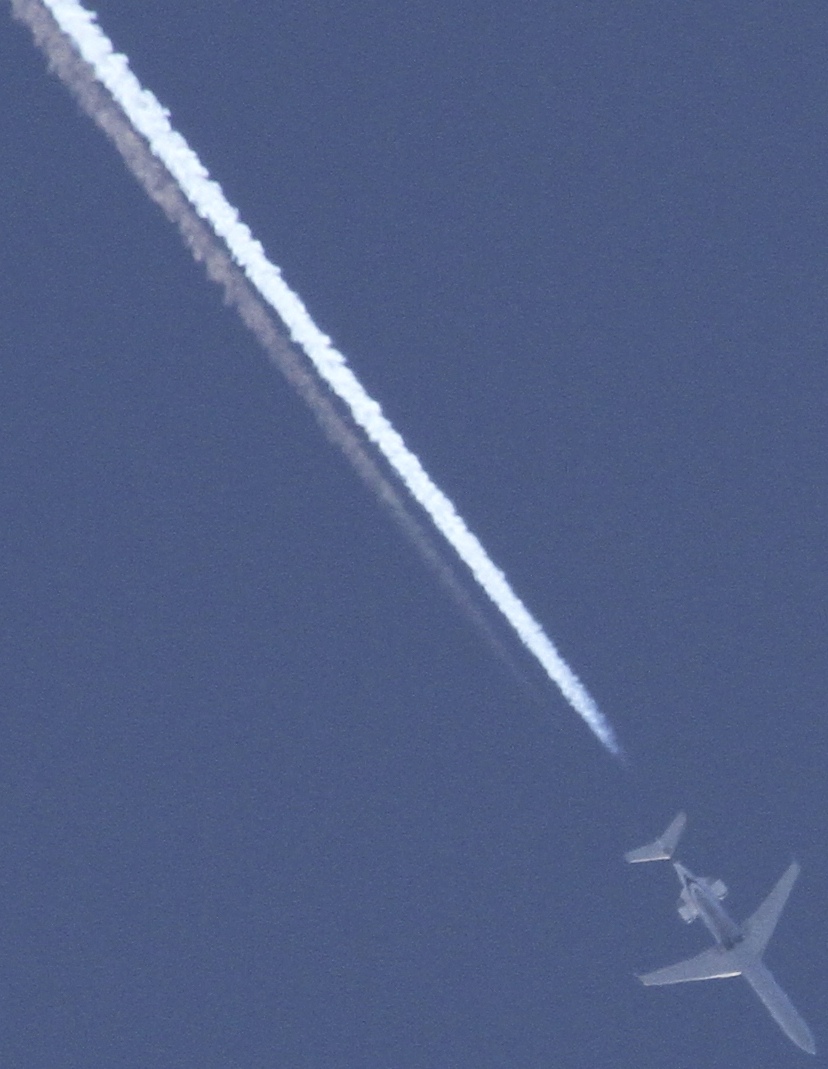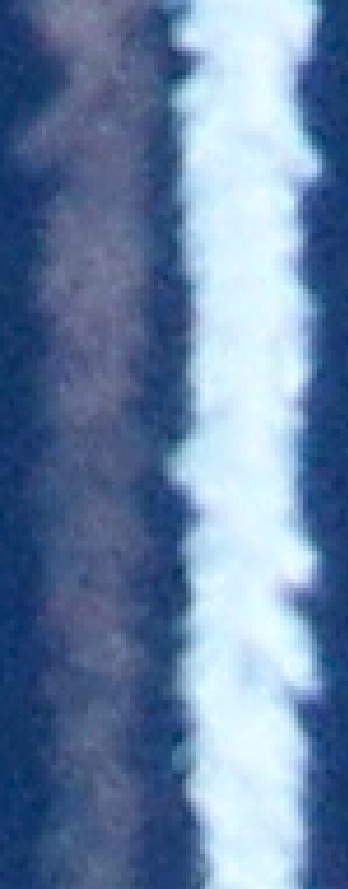Here's an interesting example of dark and light that I just took. It took me a while to figure out exactly what was going on, initially thinking it was one trail shadowing the other, but the sun is too high, and the difference far too stark for that. The explanation ended up being that the jet had two different engines.
Photos taken around 11AM PDT, 1800 UTC, 12 Noon PST. Mar 9 2014
Original photos can be found here: http://www.flickr.com/photos/metabunk/sets/72157642135454733/ (Camera time is 2m 20s fast, so subtract 2m 20s to get correct time)

The plane flew almost directly overhead, over the Santa Monica VOR, which is about a mile away. It was heading south, to San Diego.
This is one of the first photos I took, with the contrast enhanced. Here the difference is slight, but noticeable:

The denser trail on the pilot's right seems to be shadowing the trail on the left. A wider angle shows the change even out further back, but it's still there.

In the next shot, from my point of view it looks like the sun is to the left of the trail, yet the right side is much brighter and has a coloration more typical of an aerodynamic contrail.

Wider angle:

The Jet as it passed overhead. FAA data, so about five minutes behind.
http://www.flightradar24.com/2014-03-09/18:00/12x/SKW3484/2db6b8c

In the last photo I took of the plane, the trail on the left is almost invisible.

On that day, March 9th 2014, I took many photos as conditions were great for contrail formation. I did not notice the two-tone colors until later, when I was able to view them on the computer.
There were many clouds, both high cirrus, and some fractus cumulus.
I have uploaded all the photos I took to Flickr in two sets:
http://www.flickr.com/photos/metabunk/sets/72157642297148355/
http://www.flickr.com/photos/metabunk/sets/72157642135454733/
The second set just shows this CRJ700 jet with intermixed engines. The first set is all the other photos, before and after, from that day.
Of note from the CRJ set:

The distinctive color spectrum is quite noticeable. This would also be a plane flying south to San Diego, and likely descending. Notice the two trails are identical (the small third trail is probably a galley dump - water or beverages from the kitchen)
My theory is:
With the CRJ two-tone contrail, the newer engine has cooler exhaust, and so enters the rapid "condensing" portion of the mixing curve earlier than the older hotter engine, and so condenses larger droplet before transitioning through "freezing" to "deposition" and the slow ice crystal growth.
[This post has been updated with material from the thread below]
[Update] here's the most likely explanation

Photos taken around 11AM PDT, 1800 UTC, 12 Noon PST. Mar 9 2014
Original photos can be found here: http://www.flickr.com/photos/metabunk/sets/72157642135454733/ (Camera time is 2m 20s fast, so subtract 2m 20s to get correct time)

The plane flew almost directly overhead, over the Santa Monica VOR, which is about a mile away. It was heading south, to San Diego.
This is one of the first photos I took, with the contrast enhanced. Here the difference is slight, but noticeable:

The denser trail on the pilot's right seems to be shadowing the trail on the left. A wider angle shows the change even out further back, but it's still there.

In the next shot, from my point of view it looks like the sun is to the left of the trail, yet the right side is much brighter and has a coloration more typical of an aerodynamic contrail.

Wider angle:

The Jet as it passed overhead. FAA data, so about five minutes behind.
http://www.flightradar24.com/2014-03-09/18:00/12x/SKW3484/2db6b8c
In the last photo I took of the plane, the trail on the left is almost invisible.

On that day, March 9th 2014, I took many photos as conditions were great for contrail formation. I did not notice the two-tone colors until later, when I was able to view them on the computer.
There were many clouds, both high cirrus, and some fractus cumulus.
I have uploaded all the photos I took to Flickr in two sets:
http://www.flickr.com/photos/metabunk/sets/72157642297148355/
http://www.flickr.com/photos/metabunk/sets/72157642135454733/
The second set just shows this CRJ700 jet with intermixed engines. The first set is all the other photos, before and after, from that day.
Of note from the CRJ set:
- A variety of clouds are shown
- The left trail gets progressively more faint as the plane descends (it's descending towards San Diego Airport, started the descent at the time of the first photo)
- In 0703 it is descending through the cloud layer. This is the last photo I took that shows the plane.
- in 0706 the trail shows a transition from distrail to contrail, indicating where it went below the clouds, but still kept on conning.
- A nice sundog and cirrus fallstreaks in the first few photos
- The first plane (0662 to 0687) exhibits no coloration, just normal white exhaust contrails
- In 0673/4 you see distinctive "hybrid" contrails cause by the wake vortices, indicating marginal conditions (i.e. not ice supersaturated)
- 0709 to 0715 are just low altitude planes on approach to LAX.
- 0716 to 0734 all show (I think) the same plane
- 0730 to 0734 show the colors in both sides of a trail
- 0735 is a wide angle shot I took to gauge the position of the sun
- 0744 is a calibration shot, showing the camera time 2m20s fast.

The distinctive color spectrum is quite noticeable. This would also be a plane flying south to San Diego, and likely descending. Notice the two trails are identical (the small third trail is probably a galley dump - water or beverages from the kitchen)
My theory is:
- The air is marginal for contrail growth, around 100% ice supersaturated, so around 60-70% relative humidity with respect to water.
- The colored trails indicate a very short period of water condensation, followed by much slower ice crystal size increase by deposition, this progresses though the color spectrum as it increase in size..
- The white trails have a longer (but still very short) period in the the liquid phase, and so when it freezes, the ice crystal is already larger than size that creates colors
With the CRJ two-tone contrail, the newer engine has cooler exhaust, and so enters the rapid "condensing" portion of the mixing curve earlier than the older hotter engine, and so condenses larger droplet before transitioning through "freezing" to "deposition" and the slow ice crystal growth.
[This post has been updated with material from the thread below]
[Update] here's the most likely explanation

Last edited:











![IMG_1457[1].JPG](/data/attachments/5/5826-434b9f3ec75ffaffbf608a4fb8251e7e.jpg)